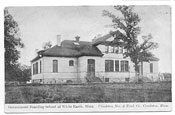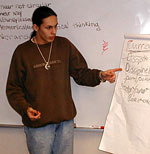| The high school diploma is a benchmark that divides those who have from those who have very little. But in Indian country, diplomas are relatively scarce. Education opportunities are too often abandoned by Native American kids facing a litany of problems, including the sting of discrimination.
 |
The first experience many Indian tribes had with public education was Indian boarding schools which were created in the late 1800s, and remained until the 1950s. This photo is of the White Earth boarding school in northern Minnesota, circa 1911.
See a slideshow of the school and its students.
(Photos courtesy of the Becker County Historical Society)
|
LOREN IS IN HIS EARLY '20s, a Yankton Sioux living in a tribal housing project near Wagner, South Dakota. Loren has no job and few prospects. Without a high school diploma, it's unlikely Loren will be able to support his wife and toddler without assistance. He says he left school after being the target of discrimination: one of a dozen Indian kids isolated on a school bus by a school official, investigating a theft.
"I was just mad, 'cause I didn't think it was right and I wanted to go home. I tried to get off, and the principal just totally lost it and he picked me up, and slammed me down, and made me even more mad," he recalls.
The facts of the incident remain in dispute, but it fanned protests, investigations, and community meetings; Loren says it's the main reason he never finished school.
"I don't know, I was just embarrassed to go back to school."
Loren dropped out, and The Sioux Messenger, a tribal paper, reported that four of the dozen American Indians students on that bus soon left school as well.
In Minnesota, state education statistics show that American Indian kids drop out of school more often than any other group. Thirty-five percent of the Native Americans who reach high school fail to graduate in four years. Many others disappear from school before ninth grade. Experts point to a web of potential factors: a lack of encouragement from home or school, poverty, and drug or alcohol problems that often lead to behavior trouble. Indian kids may not succeed because they are made to feel different.
"Racism is a very big factor," says Bert Ahern, a professor of history with the University of Minnesota, Morris, who advises Indian colleges on curriculum. He says racism in schools is most often subtle and covert.
"But then, there certainly is the overt racism. And the sense that when there is trouble in school, a child isn't working well with the teacher, the assumption is that it's the child's problem and that the parents probably are also a problem," he says.
Ahern says American Indian families value education but hold little trust in public schools. This attitude may well be history at work. In their first experience with institutionalized education, Indian children were sent to boarding schools and separated from their families. Even today school districts still rely on curriculum with a decidedly European viewpoint. Ahern says a typical public school does little to honor the tribal history or culture of Indians.
"I'm afraid our schooling systems are not really committed to the success of our Indian children. In terms of our public schools, we don't care enough that Indian children don't succeed," he says.
Since perhaps the 1960s, American society has struggled to steer its minorities into the mainstream. But some districts still demonstrate a surprising insensitivity to Indian culture.
Eighth grader Nicholas Fox became a target after a spring pep rally last year in Erskin, Minnesota.
"Well, they just started verbally assaulting me and then one of 'em punched me," says Fox.
In a takeoff on the two teams involved, the Win-E-Mac Patriots and the Red Lake Warriors, teachers dressed up as cowboys chased a group of Indians back to the reservation. Nicholas Fox was an Ojibwe student in the Win-E-Mac eighth grade. He says the skit marked him because of his Indian heritage.
"On the rest of the way home they were just talking about scalping me and my brother, and skinning us. And stuff like that. It was pretty bad," he says.
A video of the rally shocked Nick's mom, Deanne Fox.
"I broke out into tears because when I send my kids to school, when they're not in my sight, they shouldn't have to be put through anything like that You wonder why the Native American kids are dropping off of the education system by the eighth grade," she says.
Deanne Fox transferred her children and did something relatively rare among Indian parents: she filed a complaint with federal education officials. A settlement with the United States Department of Education's Office of Civil Rights led to new cultural sensitivity training for the staff at Win-E-Mac.
But Indian people rarely approach the federal government for redress, perhaps because Indian culture values modesty and humility. In the Bemidji schools, Indian Education Director Vince Byel works closely with the district's large American Indian population to help kids succeed despite cultural differences.
 |
Moon Roberts is a senior at Park Rapids high school. He practices traditional spirituality and has battled with the school over his right to carry a pouch of tobacco. He also objects to requirements that he cut his long hair to participate in sports. Long hair holds spiritual significance for Indians. He believes much of the discrimination he's faced is rooted in ignorance.
(MPR Photo/Dan Gunderson)
|
"Sometimes you get into some values and standards with traditional upbringing - that it's not good to compete against another person, and it's best to find out how best the group can survive or how best the group can think as a whole," says Byel.
Twenty percent of Bemidji's public school students are Native American, many with ties to the nearby White Earth, Red Lake and Leech Lake Ojibwe reservations. As a result, Bemidji has had to make school more relevant to its Ojibwe students.
In one classroom at Bemidji High School, a handful of students struggle with the nuances of the Ojibwe native language. Bemidji offers Ojibwe, like German or French. The district also teaches all its kids American Indian culture and history, with a focus on Minnesota's Ojibwe and Dakota tribes.
Bemidji is one of 24 Minnesota districts to receive money targeted specifically at Indian education programs.
State Program Director Yvonne Novak says School districts with specialized programs for Indian students have up to 8 percent fewer Indian kids dropping out.
"The key to that is there's Indian staff in the school that take a personal interest in those students. And that personal interest is knowing them, knowing their culture and having that one-on-one, like a coach, relationship with them," she says.
Some districts dedicate whole school buildings to American Indian learning. Minnesota's largest concentration of American Indians is in the Twin Cities, where several schools offer instruction with a decidedly Indian perspective. Still, according to the Department of Children, Families and Learning, Minneapolis graduates only 17 percent of its Indian students in four years. Many move away, many drop out.
Nationwide, the commitment to Indian education falls short, because of little interest or often because of little money. But a new approach in Congress could give minorities a powerful tool to improve public schools and reduce discrimination.
Congressman Jesse Jackson Jr., D-Illinois, has drafted a constitutional amendment that for the first time would create a new right to a high quality public education.
"Native Americans could appeal to such an amendment to improve the quality of their schools. They could also appeal to such an amendment to insure, for example, that in the future that a broader-based historical interpretation of Native American contribution to all Americans be taught in all public schools across the country," says Jackson.
Federal laws protect students from discrimination in schools, but don't elevate education to a civil right. However, successful constitutional amendments are few and far between, and Jackson's first attempt last year went nowhere. It may be that any real improvement in American Indian scholastic achievement will come on a local level from districts concerned about Indian students, and prepared to invest scarce resources into American Indian education. |